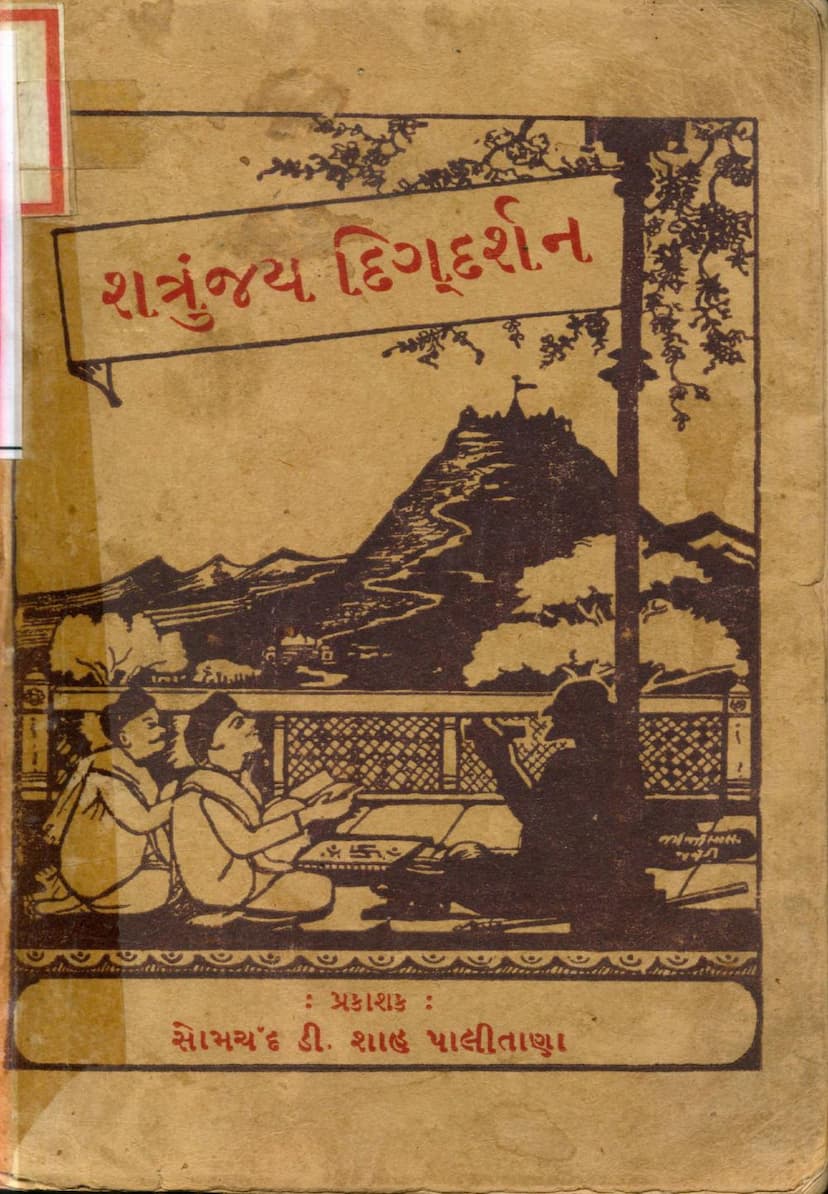Shatrunjay Digdarshan
Added to library: September 2, 2025

Summary
Here's a comprehensive summary of the Jain text "Shatrunjay Digdarshan" based on the provided pages:
Book Title: Shatrunjay Digdarshan (શત્રુંજય દિગદર્શન) Author: Muni Deepvijay (મુનિ દીપવિજય) Publisher: Somchand D. Shah, Palitana (સોમચંદ ડી. શાહે પાલીતાણા) Publication Year: Veer Samvat 2473 / Vikram Samvat 2007
Overall Purpose: This book is a guide and devotional work dedicated to the sacred Jain pilgrimage site of Shatrunjay, also known as Palitana. It aims to provide pilgrims with detailed information, rituals, historical context, and spiritual insights related to the pilgrimage to Shatrunjay, emphasizing the importance of proper conduct and reverence.
Key Themes and Content:
-
The Magnificence of Shatrunjay:
- The book begins by highlighting Shatrunjay as a preeminent and eternal holy site, a place of liberation for countless souls. Its grandeur is described as divine and awe-inspiring.
- It is noted that while other books have been written about Shatrunjay, this particular book by Muni Deepvijay offers a concise yet illuminating perspective.
-
Guidance for Pilgrims:
- The primary recommendation is for pilgrims to read this book before undertaking the journey to Shatrunjay. This will enhance their understanding, help them witness unseen aspects, and prevent inadvertent transgressions (ashatana).
- The text stresses the importance of "Vidhi and Vivek" (विधि અને વિવેક) – ritual and proper conduct – throughout the pilgrimage.
-
The Journey and Its Significance:
- The book meticulously describes the pilgrimage route, starting from the foot of the mountain. It details significant spots, footprints (padla), and idols of revered figures encountered along the way.
- Notable locations and figures mentioned include:
- Old Talati (Old base camp) and the significance of its inhabitants.
- Shri Gediji and the footprints of Parshvanath.
- Footprints of Gautam Swami and other ascetics.
- The shrine of Chakravarti Man Bharat.
- Various other shrines and footprints along the path.
- The five idols near Bavalkund, clarifying they are not the Pandavas but rather souls who attained liberation from that place.
- The significance of the six-mile (chha gau) and one-and-a-half-mile (dedh gau) circumambulations.
- The importance of understanding the history and significance of Shatrunjay in relation to other holy sites.
-
Spiritual and Ethical Conduct:
- The book provides guidance on "Hea" (things to avoid) and "Upadeya" (things to adopt) for pilgrims.
- Hea: Avoidance of night meals, root vegetables, pickles, illicit relationships, gambling, and engaging in arguments, slander, or envy.
- Upadeya: Emphasis on performing practices like Samayik, Darshan, Puja, Dan, Shila, Tap, and fostering positive Bhavana (mental disposition).
- It details the "Sheya" (things to know) about the pilgrimage, such as the meaning of pilgrimage, the reason for undertaking 99 pilgrimages, and why Shatrunjay is considered more sacred than other sites.
- The book provides guidance on "Hea" (things to avoid) and "Upadeya" (things to adopt) for pilgrims.
-
Historical Narratives and Teachings:
- The text incorporates various captivating stories and examples to illustrate Jain principles and the glory of Shatrunjay:
- The story of King Kirtidhar becoming a renunciate after witnessing a solar eclipse.
- The profound impact of the Shatrunjay pilgrimage, turning even ordinary beings into "ekavatari" (those who take only one more birth).
- The detailed account of the sixteen renovations (uddhar) of the Shatrunjay temples, including the patrons and historical periods.
- The exemplary devotion of Bhima Kudaliya, a humble individual who contributed his limited wealth with immense faith.
- The narrative of King Trivikram and his journey of repentance and spiritual attainment.
- The tale of King Kundu and King Trivikram, highlighting how even those with past negative karma could find liberation at Shatrunjay through sincere devotion and penance.
- The parable of Sukhlal Seth and Gangabai, illustrating the transformative power of spiritual guidance and the importance of charitable giving.
- The significance of the "Varshi Daan" (annual charity) and its six virtues.
- The importance of understanding the "six lotus petals" of a Shravaka (lay follower).
- The virtue of listening to religious discourses (Vyaktiyan Shravan nu Phal).
- The text incorporates various captivating stories and examples to illustrate Jain principles and the glory of Shatrunjay:
-
Rituals and Devotion:
- The book emphasizes the correct way to perform puja (worship), including the nine types of Anga Puja (worship of body parts), and the significance of each.
- It describes the process of performing circumambulations (pradakshina) around the main temple, including the "Sahasrakut" (temple with 1024 idols).
- The text provides details about the "Chaitra Purnima" significance and various rituals performed on this day.
- It highlights the importance of purifying oneself and one's surroundings during the pilgrimage.
-
The "Gata Gati" (States of Existence) Section:
- A significant portion of the book is dedicated to detailing the various states of existence (gati) of living beings, including humans, celestial beings (surs), hellish beings (narak), and animals (tiriyanch). This section provides classifications and numbers of different types of beings, their lifespans, and transmigration paths, emphasizing the Jain understanding of the cycle of birth and death. This appears to be a comprehensive cosmological and karmic explanation.
-
Theological and Philosophical Aspects:
- The text delves into the meaning of devotion, the importance of faith, and the concept of karma.
- It explains the significance of different pilgrimage routes ("Paj" or paths) and circumambulations, such as the six-mile and one-and-a-half-mile circumambulations.
- It emphasizes the need for detachment from worldly possessions and the pursuit of spiritual liberation.
In essence, "Shatrunjay Digdarshan" is a sacred manual for Jain pilgrims, offering a comprehensive blend of:
- Spiritual guidance: Encouraging devotion, right conduct, and mindfulness.
- Historical narrative: Preserving the stories and legends associated with Shatrunjay.
- Cosmological insight: Explaining the cycle of life, death, and rebirth across various realms.
- Ritualistic instruction: Detailing the proper performance of worship and pilgrimage practices.
The book is designed to deepen the pilgrim's connection to Shatrunjay and to foster a more profound and meaningful spiritual experience.